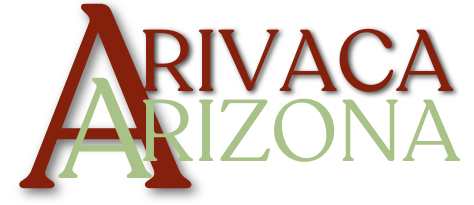Arivaca History
A Historical Perspective by Fred Noon
300 BC to 1400 AD - Area inhabited by Hohokam Indians.
1400 - The O'odham (Pima and Tonono) Indians, possibly descendants of the Hohokam, occupied the valley for many years, and named the area; "Ari" (Ali) means "little," "vaca" (wahia) refers to a place where water comes up. Early Spaniards recorded the name as Aribac.
Recorded History - 1695 - Father Kino, missionary and explorer, traveled through Aribac and included the visita of San Martin de Aribac on his map of Pimeria Alta.
1736 - A silver strike, just south of the present international boundary and known as the 'Planchas de Plata' encouraged prospectors to move north in search of silver and gold.
1751 - Pima Indian uprising against the Spaniaards. A decisive battle was fought in the area.
1776 - The Tubac Presidio moved to Tucson after Arivaca was first considered but rejected because of the poor water quality and plentiful mosquitoes (both problems now solved).
1853 - Gadsden Purchase puts Arivaca in the U.S.
1858 - Discovery of rich silver ore northeast of Arivaca. Tomas and Ignacio Ortiz sold their Aribac Land Grant to the Sonoran Exploring & Mining Co. headed by Charles Poston and Samuel Heintzelman. Samuel Colt of revolver fame was an investor. Colt sent a shipment of books - one of the first libraries in Territorial Arizona. A telegraph line from the mine to the smelter near Arivaca was the first in the Territory.
1873 Anglos began to arrive in larger numbers after Apaches put on reservation
1878-79 A post office was established. Mail was brought from Tucson by horse-drawn stages. Pedro Aguirre, merchant and freighter, built the first schoolhouse in Arivaca at his own expense. It is the oldest standing schoolhouse in the state. Dr. Adolphus Noon arrived and for the next 20 years gives medical aid to the residents.
1886 - An Apache Indian attack kills once rancher and wounds another in Bear Valley 15 miles southeast. They also raided the Jalisco Ranch to the east, but the family had fled. An earthquake rocked Southern Arizona causing cracks in buildings. The Arivaca area was a huge dust cloud and large slabs of rock broke off Montana Peak near Ruby. The epicenter was in Sonora, Mexico. A smallpox epidemic in Arizona prompted Dr. Noon to vaccinate area residents.
1896 Rand-McNally Atlas shows Arivaca population to be 236.
1911-1914 - The railroad is completed between Tucson and Nogales. Amado was the freight and passenger station - mail was delivered to Arivaca via mule-drawn buckboard. First automobiles begin to arrive in Arivaca including a King 8, a Chalmers Packard, and a Ford.
1914 - Townsite surveyed for federal patent-granted in 1916.
1916 - Connecticut National Guard Cavalrymen arrived because of unrest in Mexico. Stationed in Arivaca, they rode along the border. The Utah Cavalry barracks were erected, a new well and pumping plant and a telephone line connected the Army Post with Amado.
1918 - Influenza epidemic claimed the lives of 30 area residents.
1920-21 - A severe drought reduced cattle herds. The only stock water left was in the valley, which became a boneyard. A bone dealer hauled truckloads away for processing into bone meal.
1923 - The first major improvement of Arivaca Road - six miles near old Sopori School and the Cerro Colorado Mine using horse - drawn dirt scrapers and prairie plows.
1929 - The Eagle Pitcher Co. of Joplin, MO began development of the Montana Mine at Ruby providing jobs for area residents.
1938 - State Health Dept. investigated the mosquito problem after two cases of malaria. Gambusia fish were planted in the ponds. They thrived and provided protection to the present day.
1953-56 - Arivaca population of 66 people according to the Arivaca Briefs newspaper. Arivaca Mercantile gutted by fire. The post office was reestablished with equipment from the abandoned Ruby Post Office. Electric power lines arrived uplifting Arivaca from the dark ages.
1965 - Winter rains over eight inches caused earthen dam at Arivaca Lake to collapse, flooding the Cienega. A concrete dam was installed.
1972 - Arivaca Ranch sold 11,000 acres to a land developer who subdivided the land into 40-acre parcels.
1976 - The dirt Arivaca Road was paved
1980s and 90's -The many new residents, a result of available homesites, along with the old timers were witness to a new chronology of events, including the formation of a medical clinic, fire department, human resource office, community center and public library gained through the efforts of the local populace.
2000s - Tightening of border security brought a new era of highly visible law enforcement with it's pros and cons.
2010 - US Census - Arivaca population 695
TODAY - Arivaca is a fun little town worth experiencing. You'll feel welcomed by the local residents hanging out at Gadsen Coffee or the La Gitana Cantina. In the cooler months, Arivaca is likely to have a street fair on the first Saturday of the month. The shops are open and there's a Marian's Market - Arivaca's Farmer and Artisan Market Every Saturday - arts & crafts booths, and lots of fun things for the kids to do.
